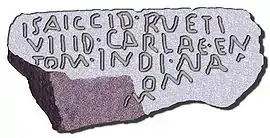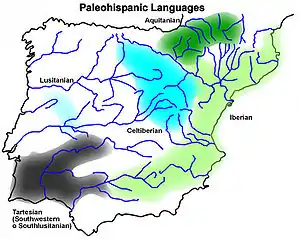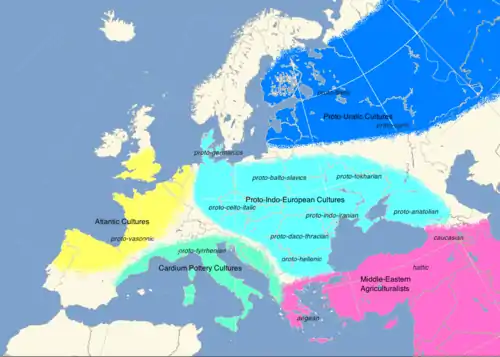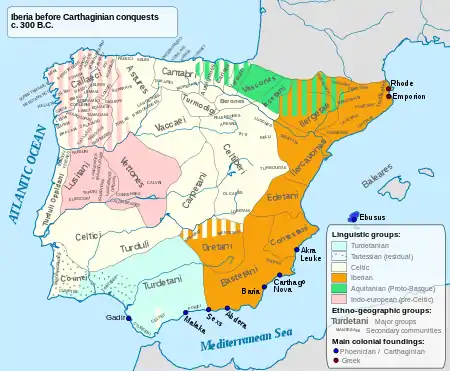Lusitanian language
Lusitanian (so named after the Lusitani or Lusitanians) was an Indo-European Paleohispanic language. There has been support for either a connection with the ancient Italic languages[1][2] or Celtic languages.[3][4] It is known from only five sizeable inscriptions, dated from circa 1 CE, and numerous names of places (toponyms) and of gods (theonyms). The language was spoken in the territory inhabited by Lusitanian tribes, from the Douro to the Tagus rivers, territory that nowadays falls in central Portugal and western Spain.[5]
| Lusitanian | |
|---|---|
 One of the inscriptions of Arroyo de la Luz. | |
| Native to | Inland central-west Iberian Peninsula |
| Region | Beira Alta, Beira Baixa and Alto Alentejo Portugal and Extremadura and part of province of Salamanca Spain |
| Extinct | 2nd century AD |
| Language codes | |
| ISO 639-3 | xls |
xls | |
| Glottolog | lusi1235 |
Classification and related languages

Lusitanian is an Indo-European language believed different from the Hispano-Celtic languages of the Iberian Peninsula. The specific language-group classification of Lusitanian has been inconclusive. According to some academics like Prósper, based on one small Lusitanian inscription found, it would not be considered a Celtic language under existing definitions of linguistic Celticity[5] because it retains Indo-European p in positions where Celtic languages would not, specifically in PORCOM 'pig' and PORGOM in another inscription, a feature considered non-Celtic. This is refuted by Anderson who links PORCOM, the accusative form of *porkos- to Middle Irish orc.[6][5] Villar and Pedrero (2001) on the other hand, connect Lusitanian with the Ligurian language. They base their finding on parallels in the names of deities and some lexical items (e.g., the similarity of Umbrian gomia and Lusitanian comaiam), and some grammatical elements.[2] This once again, raises more questions about the relation of the Lusitanian language with Celtic, because the ancient Ligurian, in many ways like Lusitanian; is considered Celtic[7] by some and non-Celtic by others. Prósper also sees Lusitanian as predating the introduction of Celtic and shows that it retains elements of Old European, making its origins possibly even older.[8] This adds to similar proposals by academics like Mallory and Koch et al. who believe the ancient Lusitanians originated from either Proto-Celtic or Proto-Italic populations who spread from Central Europe into western Europe after new Yamnaya migrations into the Danube Valley.While Proto-Germanic and Proto-Balto-Slavic may have developed east of the Carpathian mountains, in present-day Ukraine,[9] moving north and spreading with the Corded Ware culture in Middle Europe (third millennium BCE).[10][11] Alternatively, a European branch of Indo-European dialects, termed "North-west Indo-European" and associated with the Beaker culture, may have been ancestral to not only Celtic and Italic, but also to Germanic and Balto-Slavic.[12]
Scholars like Jurgen Untermann[13] have identified toponymic and anthroponymic radicals which are clearly linked to Celtic materials: briga ‘hill, fortification’, bormano ‘thermal’, karno ‘cairn’, krouk ‘hillock, mound’, crougia ‘monument, stone altar’, etc. Others, like Anderson[14] after inscriptional materials of Lusitania, Galicia and Asturias have been under closer scrutiny, with the results suggesting albeit somewhat indirectly; believe that Lusitanian and Galician-Asturian formed a fairly homogeneous linguistic group displaying closely affiliated inscriptions.[6] Indigenous divine names in Portugal and Galicia frequently revolve around the gods or goddesses Bandu, Bandi, Cossu, Nabia and Reve:
- Bandei Brialcacui, (Beira-Baixa)
- Coso Udaviniago, (A Coruña)
- Cosiovi Ascanno, (Asturias)
- deo domeno Cusu Neneoeco, (Douro)
- Reo Paramaeco, (Lugo)
- Reve Laraucu, (Ourense)
- Reve Langanidaeigui, (Beira-Baixa)
The Lusitanian-Gallaecian divine name Lucubos for example, also occurs outside the peninsula, in the plural, in Celtic Helvetia where the nominative form is Lugoves. Lug was also an Irish god, and the ancient name of Lyon was Lug dumum and may have a connection with the Lusitanian-Galician word. Suggesting therefore a Northwestern Iberian Sprachbund with Lusitanian as a dialect, not a language isolate.[15] Prominent linguists such as Ellis Evans, believe that Gallaecian-Lusitanian were one same language (not separate languages) of the “P” Celtic variant.[16][17]

While chronology, migrations and diffusion of Hispanic I.E peoples are still far from clear, there seems to be justification for assuming a Celtic dialect for ancient Portugal and Galicia-Asturias. Linguistic similarities between these Western Iberian Indo-Europeans, Celtiberians, Gauls and the Celtic peoples of Great Britain, indicate affiliation in vocabulary and linguistic structure.[6]
Furthermore, scholars such as Koch say there is no unambiguous example of the reflexes of the Indo-European syllabic resonants *l̥, *r̥, *m̥, *n̥ and the voiced aspirate stops *bʱ, *dʱ, *ɡʱ.[5] Additionally, names in the inscriptions can be read as undoubtedly Celtic, such as AMBATVS, CAELOBRIGOI and VENDICVS.[5] Dagmar Wodtko argues that it is hard to identify Lusitanian personal or place-names that are actually not Celtic.[18] These arguments contradict the hypothesis that the p- in PORCOM alone, excludes Lusitanian from the Celtic group of Pre-roman languages of Europe[19] and that it can be classed as a Celtic dialect, but one that preserved Indo-European *p (or possibly an already phonetically weakened [ɸ], written P as an archaism).[5][20][21] This is based largely on numerous Celtic personal, deity, and place names.[22][23] Lusitanian possibly shows /p/ from Indo-European *kʷ in PVMPI, pronominal PVPPID from *kʷodkʷid,[24] and PETRANIOI derived from *kʷetwor- 'four',[25] but that is a feature found in many Indo-European languages from various branches (including P-Celtic), and by itself, it has no bearing on the question of whether Lusitanian is Celtic.[26] Bua Carballo suggests that pairings on different inscriptions such as Proeneiaeco and Proinei versus Broeneiae, and Lapoena versus Laboena, may cast doubt on the presence of a P sound in Lusitanian.[27] Some scholars have proposed that it may be a para-Celtic language, which evolved alongside Celtic or formed a dialect continuum or sprachbund with Tartessian and Gallaecian. This is tied to a theory of an Iberian origin for the Celtic languages.:[28][29][30] It is also possible that the Q-Celtic languages alone, including Goidelic, originated in western Iberia (a theory that was first put forward by Edward Lhuyd in 1707) or shared a common linguistic ancestor with Lusitanian.[31] Secondary evidence for this hypothesis has been found in research by biological scientists, who have identified (firstly) deep-rooted similarities in human DNA found precisely in both the former Lusitania and Ireland,[32][33] and; (secondly) the so-called "Lusitanian distribution" of animals and plants unique to western Iberia and Ireland. Both of these phenomena are now generally believed to have resulted from human emigration from Iberia to Ireland, during the late Paleolithic or early Mesolithic eras.[34]
Geographical distribution

Inscriptions have been found Cabeço das Fráguas (in Guarda), in Moledo (Viseu), in Arroyo de la Luz (in Cáceres) and most recently in Ribeira da Venda. Taking into account Lusitanian theonyms, anthroponyms and toponyms, the Lusitanian sphere would include modern northeastern Portugal and adjacent areas in Spain, particularly Galicia, with the centre in Serra da Estrela.
The most famous inscriptions are those from Cabeço das Fráguas and Lamas de Moledo in Portugal, and Arroyo de la Luz in Spain. Ribeira da Venda is the most recently discovered (2008).
A bilingual Lusitanian-Latin votive inscription is reported to attest the ancient name of Portuguese city of Viseu: Vissaîegobor.[35]
Writing system
All the known inscriptions are written in the Latin alphabet. It is difficult to determine if the letters have a different pronunciation than the Latin values, but the frequent alternations of c with g (porcom vs. porgom) and t with d (ifadem vs. ifate), and the frequent loss of g between vowels points to a lenis pronunciation compared to Latin. In particular, between vowels and after r, b may have represented the sound /β/, and correspondingly g was written for /ɣ/, and d for /ð/.
Inscriptions
RUFUS ET
TIRO SCRIP
SERUNT
VEAMINICORI
DOENTI
ANGOM
LAMATICOM
CROUCEAI
MAGA
REAICOI PETRANIOI R[?]
ADOM PORGOMIOUEA [or ...IOUEAI]
CAELOBRIGOI
Cabeço das Fráguas:[37]
OILAM TREBOPALA
INDO PORCOM LAEBO
COMAIAM ICONA LOIM
INNA OILAM USSEAM
TREBARUNE INDI TAUROM
IFADEM REUE...
Translation:[23]
A sheep [lamb?] for Trebopala
and a pig for Laebo,
[a sheep] of the same age for Iccona Loiminna,
a one year old sheep for
Trebaruna and a fertile bull...
for Reve...
Arroyo de la Luz (I & II):
AMBATVS
SCRIPSI
CARLAE PRAISOM
SECIAS ERBA MVITIE
AS ARIMO PRAESO
NDO SINGEIETO
INI AVA INDI VEA
VN INDI VEDAGA
ROM TEVCAECOM
INDI NVRIM INDI
VDEVEC RVRSENCO
AMPILVA
INDI
LOEMINA INDI ENV
PETANIM INDI AR
IMOM SINTAMO
M INDI TEVCOM
SINTAMO
Arroyo de la Luz (III):[38]
ISACCID·RVETI ·
PVPPID·CARLAE·EN
ETOM·INDI·NA.[
....]CE·IOM·
M·
Ribeira da Venda:[1]
[- - - - - -] AM•OILAM•ERBAM [---]
HARASE•OILA•X•BROENEIAE•H[------]
[....]OILA•X•REVE AHARACVI•TAV[---]
IFATE•X•BANDI HARACVI AV[---]
MVNITIE CARIA CANTIBIDONE•[--
APINVS•VENDICVS•ERIACAINV[S]
OVGVI[-]ANI
ICCINVI•PANDITI•ATTEDIA•M•TR
PVMPI•CANTI•AILATIO

Notes
- Prósper, Blanca Maria; Villar, Francisco (2009). "Nueva inscripción lusitana procedente de Portalegre". Emerita. LXXVII (1): 1–32. doi:10.3989/emerita.2009.v77.i1.304. Archived from the original on 1 July 2012. Retrieved 11 June 2012.
- Villar, Francisco (2000). Indoeuropeos y no indoeuropeos en la Hispania Prerromana (in Spanish) (1st ed.). Salamanca: Ediciones Universidad de Salamanca. ISBN 84-7800-968-X. Archived from the original on 31 December 2015. Retrieved 22 September 2014.
- Kruta, Venceslas (1991). The Celts. Thames and Hudson. p. 55.
- Stifter, David (2006). Sengoídelc (Old Irish for Beginners). Syracuse University Press. pp. 3, 7. ISBN 0-8156-3072-7.
- Koch, John T (2011). Tartessian 2: The Inscription of Mesas do Castelinho ro and the Verbal Complex. Preliminaries to Historical Phonology. Oxbow Books, Oxford, UK. pp. 33–34. ISBN 978-1-907029-07-3. Archived from the original on 23 July 2011.
- https://www.persee.fr/doc/rea_0035-2004_1985_num_87_3_4212
- Markey, Thomas (2008). Shared Symbolics, Genre Diffusion, Token Perception and Late Literacy in North-Western Europe. NOWELE.
- Prósper, BM (1999). "The inscription of Cabeço das Fráguas revisited. Lusitanian and Alteuropäisch populations in the West of the Iberian Peninsula". Transactions of the Philological Society. Wiley. 97 (2): 151–184. doi:10.1111/1467-968X.00047.
- Anthony 2007, pp. 368, 380.
- Mallory 1999, pp. 108, 244–250.
- Anthony 2007, p. 360.
- James P. Mallory (2013). "The Indo-Europeanization of Atlantic Europe". In J. T. Koch; B. Cunliffe (eds.). Celtic From the West 2: Rethinking the Bronze Age and the Arrival of Indo–European in Atlantic Europe. Oxford: Oxbow Books. pp. 17–40.
- "Lusitanisch, Keltiberisch, Keltisch", Studia Palaeohispanica. Jurgen Untermann, 1987. Vitoria 1987, pp. 57-76.
- Anderson, JM. "Preroman indo-european languages of the hispanic peninsula". Revue des Études Anciennes Année 1985 87-3-4 pp. 319-326.
- https://repositorio-aberto.up.pt/bitstream/10216/72404/2/28609.pdf
- https://ilg.usc.es/agon/wp-content/uploads/2010/09/Callaica_Nomina.pdf
- Celtic Culture: A-Celti. 2006. ISBN 9781851094400.
- Wodtko, Dagmar S (2010). Celtic from the West Chapter 11: The Problem of Lusitanian. Oxbow Books, Oxford, UK. pp. 335–367. ISBN 978-1-84217-410-4.
- Ballester, X. (2004). "Hablas indoeuropeas y anindoeuropeas en la Hispania prerromana". Real Academia de Cultura Valenciana, Sección de Estudios Ibéricos. Estudios de Lenguas y Epigrafía Antiguas –ELEA. 6: 114–116.
- Anderson, J. M. 1985. «Pre-Roman Indo-European languages of the Hispanic Peninsula», Revue des Études Anciennes 87, 1985, pp. 319–326.
- Untermann, J. 1987. «Lusitanisch, Keltiberisch, Keltisch», in: J. Gorrochategui, J. L. Melena & J. Santos (eds.), Studia Palaeohispanica. Actas del IV Coloquio sobre Lenguas y Culturas Paleohispánicas (Vitoria/Gasteiz, 6–10 mayo 1985). (= Veleia 2–3, 1985–1986), Vitoria-Gasteiz ,1987, pp. 57–76.
- Pedreño, Juan Carlos Olivares (2005). "Celtic Gods of the Iberian Peninsula". E-Keltoi: Journal of Interdisciplinary Celtic Studies. 6 (1). Archived from the original on 24 September 2009. Retrieved 12 May 2010.
- Quintela, Marco V. García (2005). "Celtic Elements in Northwestern Spain in Pre-Roman times". E-Keltoi: Journal of Interdisciplinary Celtic Studies. Center for Celtic Studies, University of Wisconsin-Milwaukee. 6 (1). Archived from the original on 6 January 2011. Retrieved 12 May 2010.
- Koch, John T (2010). Celtic from the West Chapter 9: Paradigm Shift? Interpreting Tartessian as Celtic. Oxbow Books, Oxford, UK. p. 293. ISBN 978-1-84217-410-4.
- Zair, Nicholas. "Latin Bardus and Gurdus". Glotta 94 (2018): 311-18. doi:10.2307/26540737.
- Wodtko 2010, p.252
- Búa Carballo., D. Carlos (2014). "I". III CONGRESSO INTERNACIONAL SOBRE CULTURA CELTA "Os Celtas da Europa Atlântica". Instituto Galego de Estudos Célticos (IGEC). p. 112. ISBN 978-84-697-2178-0.
- Wodtko, Dagmar S (2010). Celtic from the West Chapter 11: The Problem of Lusitanian. Oxbow Books, Oxford, UK. pp. 360–361. ISBN 978-1-84217-410-4.
- Cunliffe, Barry (2003). The Celts – A Very Short Introduction – see figure 7. Oxford University Press. pp. 51–52. ISBN 0-19-280418-9.
- Ballester, X. (2004). ""Páramo" o del problema del la */p/ en celtoide". Studi Celtici. 3: 45–56.
- Asmus, Sabine; Braid, Barbara (2014). Unity in Diversity, Volume 2: Cultural and Linguistic Markers of the Concept. Cambridge Scholars Publishing. p. 8. ISBN 978-1-4438-6589-0.
- Hill, E. W.; Jobling, M. A.; Bradley, D. G. (2000). "Y chromosome variation and Irish origins". Nature. 404 (6776): 351–352. Bibcode:2000Natur.404..351H. doi:10.1038/35006158. PMID 10746711. S2CID 4414538.
- McEvoy, B.; Richards, M.; Forster, P.; Bradley, D. G. (2004). "The longue durée of genetic ancestry: multiple genetic marker systems and Celtic origins on the Atlantic facade of Europe". Am. J. Hum. Genet. 75 (4): 693–702. doi:10.1086/424697. PMC 1182057. PMID 15309688.
- Masheretti, S.; Rogatcheva, M. B.; Gündüz, I.; Fredga, K.; Searle, J. B. (2003). "How did pygmy shrews colonize Ireland? Clues from a phylogenetic analysis of mitochondrial cytochrome b sequences". Proc. R. Soc. B. 270 (1524): 1593–1599. doi:10.1098/rspb.2003.2406. PMC 1691416. PMID 12908980.
- Ruiz, J. Siles. "Sobre la inscripción lusitano-latina de Visseu". In: Nuevas interpretaciones del Mundo Antiguo: papers in honor of professor José Luis Melena on the occasion of his retirement / coord. por Elena Redondo Moyano, María José García Soler, 2016. pp. 347-356. ISBN 978-84-9082-481-8
- Hübner, E. (ed.) Corpus Inscriptionum Latinarum vol. II, Supplementum. Berlin: G. Reimer (1892)
- Untermann, J. Monumenta Linguarum Hispanicarum (1980–97)
- Villar, F. and Pedrero, R. La nueva inscripción lusitana: Arroyo de la Luz III (2001) (in Spanish)
Further reading
- Anthony, David W. (2007): The Horse, the Wheel and Language. Princeton, NJ. pp. 360–380.
- Cardim Ribeiro, José. (2014). “We give you this lamb, o Trebopala!”: the lusitanian invocation of Cabeço das Fráguas (Portugal). Conimbriga. 53. 99-144. 10.14195/1647-8657_53_4.
- Cardim Ribeiro, José. (2009) “Terão certos teónimos paleohispânicos sido alvo de interpretações (pseudo-)etimológicas durante a romanidade passíveis de se reflectirem nos respectivos cultos?”. In: Acta Paleohispanica X - Paleohispanica Volume 9 (2009). pp. 247–270. ISSN 1578-5386
- Gorrochategui, Joaquín (1987): «En torno a la clasificación del lusitano», Actas del IV coloquio sobre lenguas y culturas paleohispanicas, pp. 2–3.
- Luján, Eugenio. (2019). Language and writing among the Lusitanians. In: Paleohispanic Languages and Epigraphies. pp. 304–334. [10.1093/oso/9780198790822.003.0011.]
- Mallory, J.P. (2016): Archaeology and language shift in Atlantic Europe, in Celtic from the West 3, eds Koch, J.T. & Cunliffe, B.. Oxford: Oxbow, pp. 387–406.
- Prósper, Blanca M. y Villar, Francisco. "NUEVA INSCRIPCIÓN LUSITANA PROCEDENTE DE PORTALEGRE". In: EMERITA, Revista de Lingüística y Filología Clásica (EM) LXXVII 1, enero-junio de 2009, pp. 1–32. ISSN 0013-6662
- Untermann, Jürgen (1997): «Lusitanisch, keltiberisch, keltisch», Veleia 2–3, pp. 57–76.
- Untermann, Jürgen (1997): Monumenta Linguarum Hispanicarum. IV Die tartessischen, keltiberischen und lusitanischen Inschriften, Wiesbaden.
- Vallejo, José M.ª (2013). "Hacia Una Definición Del Lusitano". In: Palaeohispanica. Revista Sobre Lenguas Y Culturas De La Hispania Antigua n.º 13 (julio). pp. 273-91. https://ifc.dpz.es/ojs/index.php/palaeohispanica/article/view/165.
- Villar, Francisco (1996): Los indoeuropeos y los orígenes de Europa, Madrid.
- Villar, Francisco; Pedrero Rosa (2001): «La nueva inscripción lusitana: Arroyo de la Luz III», Religión, lengua y cultura prerromanas de Hispania, pp. 663–698.
- Wodtko, Dagmar S. "Lusitanisch". In: Palaeohispanica: revista sobre lenguas y culturas de la Hispania antigua n. 20 (2020): pp. 689–719. ISSN 1578-5386 DOI: 10.36707/palaeohispanica.v0i20.379
External links
- Lusitanian in LINGVÆ·IMPERII (Spanish)
- Detailed map of the Pre-Roman Peoples of Iberia (around 200 BC)
- Study of the Ribeira da Venda inscription (Portuguese)
- What is necessary to decide if Lusitanian is a Celtic language?